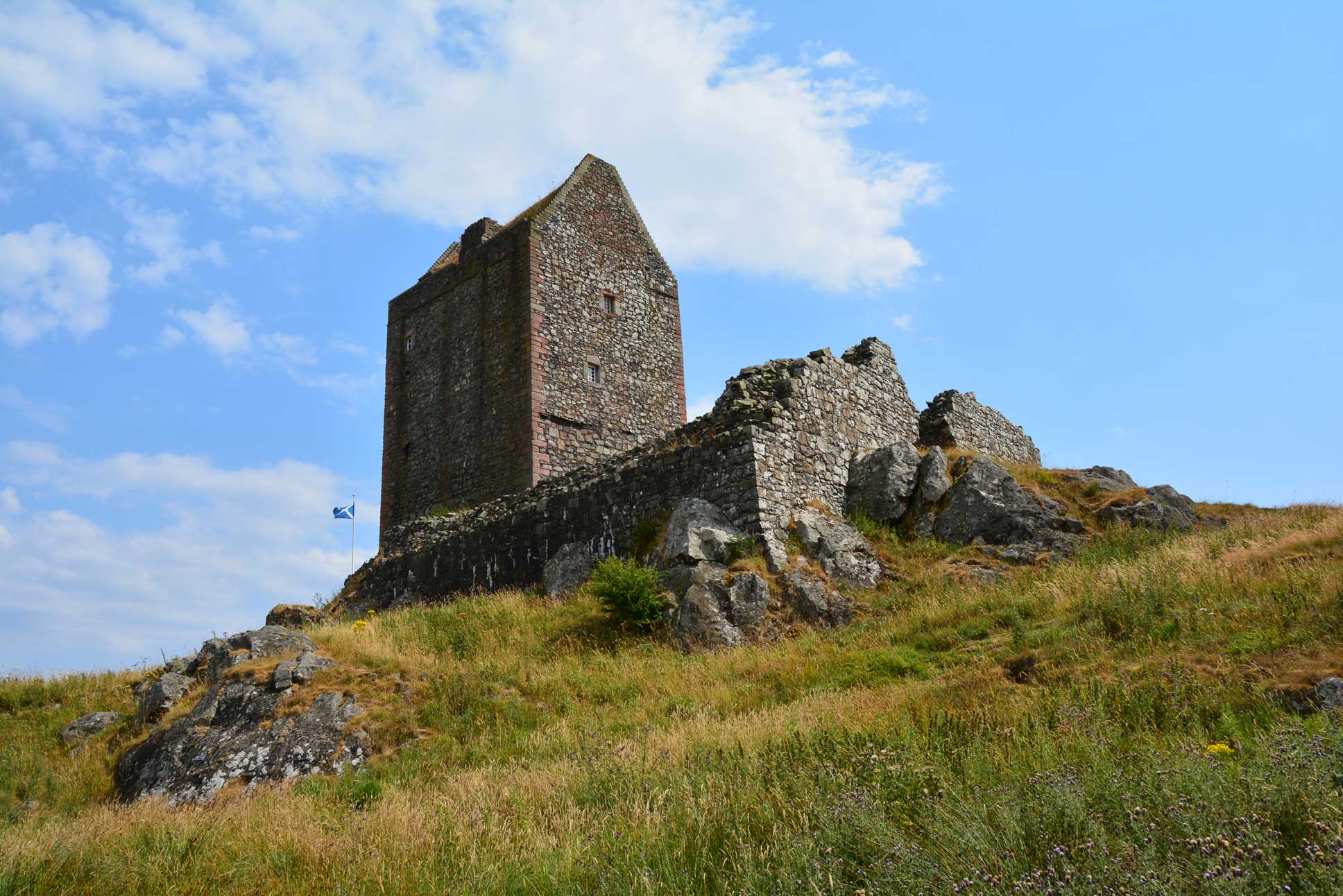History
Smailholm Tower resides atop the rocky outcrop summit of Lady Hill along the Scottish borders. Its history involves two notable Scottish families, namely the Pringles, known initially as the Hoppringills, and the Scotts of Harden, who were ancestors of Sir Walter Scott.

The precise date for the construction of Smailholm Tower is unknown. George Pringle owned the land before 1459, when his brother Robert succeeded him as laird. Given the peel style of the tower and inverted keyhole gun loop above the entrance, the fortification was likely built during the middle of the 15th century. However, some clues hint the tower may have been made before 1455 when the Pringles served as squires to the Earls of Douglas (Black Douglas line of the Douglas family). Since the architecture of Smailholm Tower is similar but smaller compared to the early 15th century Black Douglases residence of Newark Castle, many surmised that the Pringles were mimicking the style of the Douglas Clan on a less ambitious scale. A heart-shaped decorative motif near the hall fireplace of Smailholm Tower was closely related to the Earls of Douglas, who fell from power in 1455. Consequently, it is doubtful Smailholm Tower was constructed after that time.
Between the 13th and 17th centuries, Scotland's border region was a turbulent area fraught with danger and pillaging from raiders along the English/Scottish border. Smailholm Tower protected the area from such groups but suffered losses due to English raiders attacking the castle and nearby village in 1543, 1544, and 1546. One such account thereof is provided below.
A party of reivers from Tynedale and Redesdale … with certain assured Scots took up Smailholm village and Smailholm Craig and took away 100 prisoners, 600 cattle, 100 horses, and much more household furnishings.
The constant raids of John Pringle's lands and castle drove him to become an Assured Scot in 1548. Accordingly, he refused to initiate forays against England and confrontations with Englishmen operating in Scotland. In return, Pringle was promised his property would be left alone. Thereafter, no further raids against Smailholm were recorded. The Pringle family owned other estates in the border region of Scotland, especially in Galashiels on the edge of the Ettrick Forest. Over time, they relocated to Galashiels and leased the tower to various families until Sir James Pringle died in 1635. A decade later, in 1645, the Pringle family sold Smailholm Tower to William Scott of Harden. Smailholm Tower experienced a brief brush with war in July 1640 during the English Civil War when Sir Andrew Ker of Greenhead temporarily occupied it. An armed band of Covenanters successfully defended themselves and Smailholm Tower from assault by a detachment of musketeers from a Royalist regiment.
William Scott of Harden, already occupying an estate elsewhere, leased Smailholm Tower to his kinsman, Walter "Beardie" Scott, great-grandfather of Sir Walter Scott. During this time, the courtyard buildings were erected within the west courtyard of the tower, as well as a barmkin, the stone perimeter wall around the square. After their construction, the tower served less of a role as a primary residence. At the beginning of the 18th century, Sir William Scott recorded that an elderly dowager lady once resided at Smailholm Tower. Her death probably caused the family to abandon the rocky summit and move to a more comfortable residence in the hollow of Sandyknowe. Sir Walter Scott's occasional visits to the castle ruins as a child greatly influenced his writings. In the poem entitled "Marmion," he writes about the tower as follows:
And still I thought that shatter’d tower
The mightiest work of human power;
And marvell’d as the aged hind
With some strange tale bewitch’d my mind,
Of forayers, who, with headlong force,
Down from that strength had spurr’d their horse,
Their southern rapine to renew,
For in the distant cheviot blue,
And, home returning, fill’d the hall,
With revel, wassel-rout, and brawl
Methought grim features, seam’d with scars,
Glared through the window’s rusty bars,
And ever, by the winter hearth,
Old tales I heard of woe and mirth,
Of lovers’ slights, of ladies’ charms,
Of witches’ spells, of warriors’ arms
The last owner, Earl of Ellesmere, transferred the property to state care in 1950. It was restored in the 1980s and currently operates as a museum.
Castle Highlights
Standing upon its rocky crag, Smailholm Tower appears quite intimidating for a Peel Tower. It is rumored on a clear day, from the top of the tower, you can see Bamburgh Castle along the coast of Northumberland, England, more than 33 miles away. Due to my fear of heights, I did not attempt to confirm whether this was an accurate statement. However, the tower's rooftop is accessible to visitors who may want to explore for themselves. The rooftop of Smailholm Tower also has a watchman's seat and a recess for his lantern, likely attributed to this line from the Laws of Marches in 1570:
"Everie man that hath a castle or towre of stone shall, upon everie fray raysed in the night, give warning to the countrie by fire in the topps of the castle or towre."
The rectangular-shaped tower with six-foot thick walls represents most of the site today. A single arched red sandstone doorway that leads into the building still retains the original iron-gate inner door. In contrast, the initial outer wooden door was previously replaced. The hall occupying the tower's third level includes a large fireplace and grandiose windows flanked by stone seats. The story above the hall served as the laird's private chamber. While outer courtyard buildings and barmkin exist as partial walls and foundations today, their remnants still give visitors a notion concerning their original dimensions. The facilities included a hall on one side and a smaller kitchen opposite.
Smailholm Tower can be thoroughly explored in a couple of hours. While possible to explore Hermitage Castle on the same day, it represents somewhat of a distance to drive. Alternatively, nearby Dryburgh Abbey and Jedburgh Abbey are well worth a visit.


